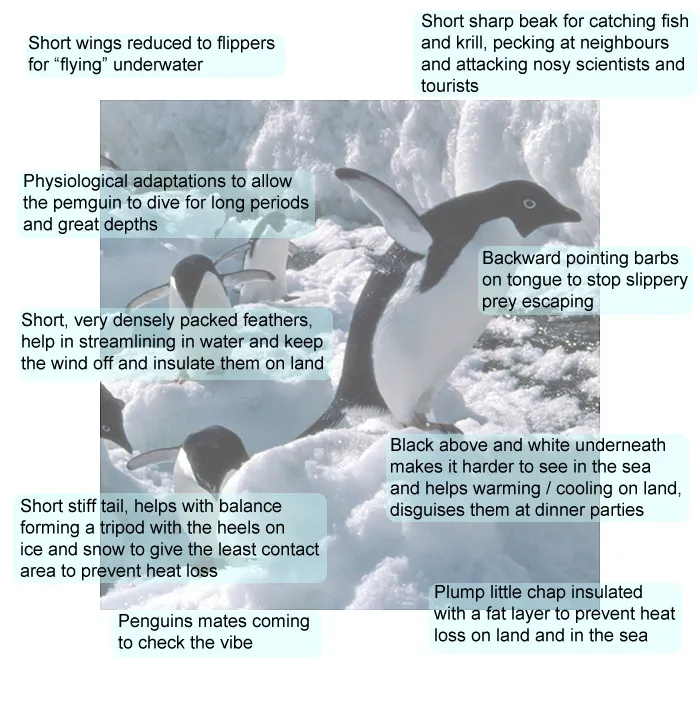Emperor penguin
Aptenodytes
forsteriaa
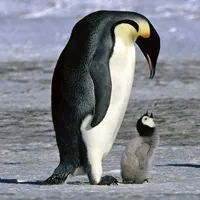
Largest of all penguins by a considerable
margin. Animals of the very deep south and the only
large animal that remains in Antarctica in the depths
of the long dark winter night.
More about
emperor penguin adaptations
Anatomical
Adaptations
 Large size retains heat - Emperors are twice the size
of the next biggest penguin,
Large size retains heat - Emperors are twice the size
of the next biggest penguin, the king, so are able
to survive the winter fast and the extreme cold temperatures
endured at this time
 Short stiff tail
Short stiff tail helps balance on land, forms a
tripod with heels on ice to give the least contact area
to prevent heat loss
 Chicks have soft down for insulation,
Chicks have soft down for insulation, this is a
more effective insulator on land than the parents feathers,
but of little use in the sea, they must moult before
they can swim
Behavioural
Adaptations
 Huddle together in the winter to conserve heat,
Huddle together in the winter to conserve heat,
without this they wouldn't be able to survive the
Antarctic winter
 Unlike other penguin species, they are not aggressively
territorial,
Unlike other penguin species, they are not aggressively
territorial, hence the huddling (above)
 Breed during the depths of the Antarctic winter,
Breed during the depths of the Antarctic winter,
so the chicks are large enough to become independent
during the summer abundance of food
Physiological
Adaptations
 A complex heat exchange system
A complex heat exchange system allows 80% of heat
in the breath to be recaptured in the nasal passages
 They can dive to a depth of 1,800 feet (550 meters)
and hold their breath for up to 22 minutes,
They can dive to a depth of 1,800 feet (550 meters)
and hold their breath for up to 22 minutes, so are
able to reach and exploit food resources that other
birds can't reach
 Males can make "milk"
Males can make "milk" in the oesophagus
which can be used to feed chicks in the winter before
the female arrives back from fishing
Adelie penguin
Pygoscelis
adeliae
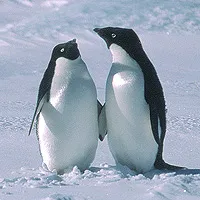
The second most southerly penguin species
after the Emperor, breed in the far south, but leave
it to head north with the onset of winter.
More about
adelie penguin adaptations
Anatomical
Adaptations
 Short wings reduced to flippers
Short wings reduced to flippers for swimming underwater
 Backward pointing barbs on tongue
Backward pointing barbs on tongue to stop slippery
prey escaping
 Black above and white underneath
Black above and white underneath makes it harder
to see in the sea, and helps warming / cooling on land,
back or front to the sun according to whether they are
hot or cold
Behavioural
Adaptations
 Migrate north
Migrate north at the end of the brief summer
 Arrive in the south early in the summer season,
to take best advantage of the seasonal abundance of
food
Arrive in the south early in the summer season,
to take best advantage of the seasonal abundance of
food
 Tobogganing sliding on their front while pushing
with legs, saves a lot of energy in long journeys
Tobogganing sliding on their front while pushing
with legs, saves a lot of energy in long journeys
Physiological
Adaptations
 Muscle has large amounts of myoglobin
Muscle has large amounts of myoglobin to hold extra
oxygen that is used up during a dive
 A counter-current system in the legs
A counter-current system in the legs means that
the feet are kept just above freezing and operated by
muscles in the legs via tendons, this reduces heat loss
 During a deep dive, the heart rate slows
During a deep dive, the heart rate slows from 80-100
down to 20 beats per minute
Weddell Seal
Leptonychotes
wedelli
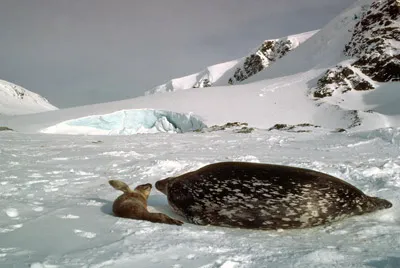
The most southerly dwelling of all mammals.
Live at the edge of pack ice wherever there is a breathing
hole or tide crack.
More about Weddell
seal adaptations
Anatomical
Adaptations
 Fore and hind limbs developed into flippers for swimming
Fore and hind limbs developed into flippers for swimming
 Smooth, streamlined shape
Smooth, streamlined shape to pass easily through
the water
 A substantial blubber layer
A substantial blubber layer lies under the skin
acting as insulation, so allowing the seals to swim
indefinitely in frigid Antarctic waters down to -2C
Behavioural
Adaptations
 Seals keep open breathing holes in the ice
Seals keep open breathing holes in the ice by rasping
back and forth with their teeth, so allowing them to
live further south than any other mammal
 They can swim large distances between breathing holes
They can swim large distances between breathing holes
and cracks, finding the next hole using a form of
sonar with high pitched sounds
 They avoid the "bends" when diving by exhaling
first
They avoid the "bends" when diving by exhaling
first and allowing the lungs and air passages to
collapse
Physiological
Adaptations
 Weddell seals can dive for over an hour,
Weddell seals can dive for over an hour, though
20 minute dives are more common. They can dive to 600m
 The "cost" of diving in terms of extra oxygen
consumption is about 1.5 x the sleeping rate -
The "cost" of diving in terms of extra oxygen
consumption is about 1.5 x the sleeping rate - this
is much lower than other diving seals and birds
 The blood has high haemoglobin concentrations
The blood has high haemoglobin concentrations and
can carry 1.6 times more oxygen than human blood
Antarctic Krill
Euphausia
superba
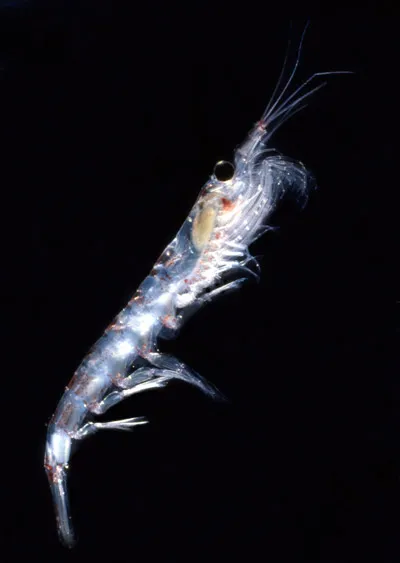
A Crustacean member of the zooplankton,
krill are about 4-5cm long and feed on phytoplankton.
Unusually large for zooplankton they are eaten by just
about anything and everything that comes across them
More about
krill adaptations
Anatomical
Adaptations
 Very fine filtering net or "basket" formed
by 6-8 pairs of limbs
Very fine filtering net or "basket" formed
by 6-8 pairs of limbs that can capture phytoplankton
down to 1 micrometer (a millionth of a meter), the smallest
that there are
, no other zooplankton of this
size can do this
 Small bioluminescent organs
Small bioluminescent organs are found on several
places on a krill's body, they have a reflector
at the back, a lens at the front and can be directed
using muscles, the function is not fully known, it may
be connected with schooling or mating
. For this
reason krill are sometimes called "light shrimp"
Behavioural
Adaptations
 Swarming behaviour similar to schools of small fish
Swarming behaviour similar to schools of small fish
as a defence against predators, such swarms can have
up to 10,000 to 30,000 individuals per cubic meter of
sea water
 In the winter and spring they are found beneath sea
ice
In the winter and spring they are found beneath sea
ice where they feed on algae growing on the under
side of the ice which they rake off in a methodical
manner like a lawn mower
Physiological
Adaptations
 Can withstand long periods of starvation (up to 200
days)
Can withstand long periods of starvation (up to 200
days) by using their muscle as a reserve, the krill
shrink in the process, this happens over the winter
months when the krill are under seasonal sea ice and
there is little or no photosynthesis
 Female Antarctic krill can lay up to 10,000 eggs at
a time,
Female Antarctic krill can lay up to 10,000 eggs at
a time, they can do this several times in a season
Blue Whale
Balaenoptera
musculus Sulphur Bottom Whale
Sibbald's
Rorqual
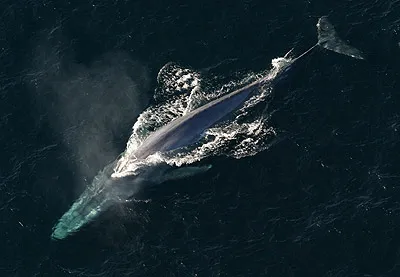
The largest animal ever to have lived, larger than
any dinosaur, the huge bulk being supported by the sea.
They can eat up to 4 tonnes of food a day in the Antarctic
summer, they feed for about 8 months and then fast for
4 months living off their fat reserves.
More about whale
adaptations
Anatomical
Adaptations
 Baleen plates in the mouth instead of teeth,
Baleen plates in the mouth instead of teeth, made
of keratin, the same tough protein that makes hair and
nails. They hang down from the upper jaw forming the
two uprights of a triangle with the lower jaw being
the flat third side.
 55 - 68 ventral grooves that extend from the lower jaw
to the navel.
55 - 68 ventral grooves that extend from the lower jaw
to the navel. These allow a huge mouthful of water
and food to be taken, expanding to about 6 times larger
than normal size.
 Blowholes (the two nostrils) located on top of the head.
Blowholes (the two nostrils) located on top of the head.
Behavioural
Adaptations
 Blue whales migrate to polar regions during the summer
months of that region.
Blue whales migrate to polar regions during the summer
months of that region. There are distinct southern
and northern populations which go to their respective
pole, none go to both poles.
 Blue whales use sound to communicate with each other
and also possibly as a means of finding krill swarms.
Blue whales use sound to communicate with each other
and also possibly as a means of finding krill swarms.
They have been described as making the loudest noise
made by any animal at 180 dB or more.
Physiological
Adaptations
 Adult blue whales have a daily energy requirement in
the region of 6.3 million Kilojoules
Adult blue whales have a daily energy requirement in
the region of 6.3 million Kilojoules (1.5 million
kilocalories). This is supplied by up to 3.6 tonnes
or 40 million individual krill eaten per day which all
have to be processed by the digestive system.
 Like many other air breathing diving animals such as
other whales, seals, and penguins, blue whales have
muscles rich in myoglobin.
Like many other air breathing diving animals such as
other whales, seals, and penguins, blue whales have
muscles rich in myoglobin. This is an iron containing
protein similar to haemoglobin that stores oxygen in
the muscles.
![]() Arrive in the south early in the summer season,
to take best advantage of the seasonal abundance of
food
Arrive in the south early in the summer season,
to take best advantage of the seasonal abundance of
food![]() Tobogganing sliding on their front while pushing
with legs, saves a lot of energy in long journeys
Tobogganing sliding on their front while pushing
with legs, saves a lot of energy in long journeys